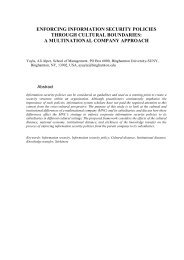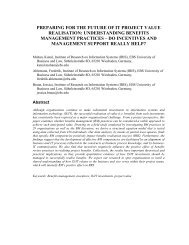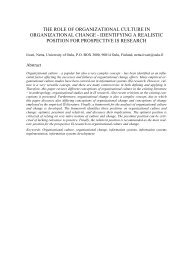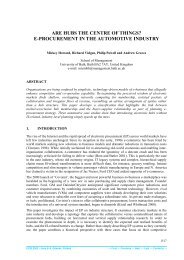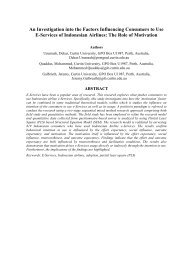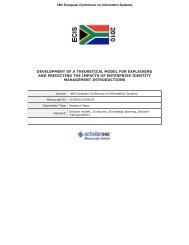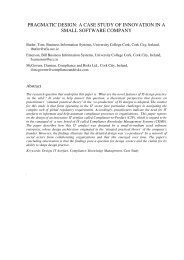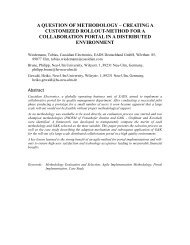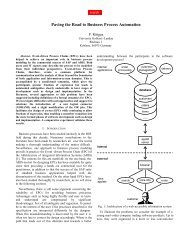Implementing Customer Relationship Management in the Hotel Sector
Implementing Customer Relationship Management in the Hotel Sector
Implementing Customer Relationship Management in the Hotel Sector
You also want an ePaper? Increase the reach of your titles
YUMPU automatically turns print PDFs into web optimized ePapers that Google loves.
Marianna Sigala <strong>Customer</strong> <strong>Relationship</strong> <strong>Management</strong> <strong>in</strong> <strong>Hotel</strong>s<br />
Indicate <strong>the</strong> importance of <strong>the</strong><br />
follow<strong>in</strong>g factors for successful<br />
CRM implementation (5 po<strong>in</strong>t scale,<br />
irrelevant - essential)<br />
1 – 60<br />
room<br />
s<br />
SD<br />
61 +<br />
room<br />
s<br />
SD<br />
tvalue<br />
Autonomous and/or <strong>in</strong>terdepartmental<br />
teams 2.42 1.14 3.61 1.04 4.03<br />
p.<br />
0.000*<br />
Assignment of a knowledge /<br />
<strong>in</strong>formation officer 2.31 1.03 3.34 1.12 3.85 0.002*<br />
Organisational culture 4.04 1.02 4.34 0.87 0.852 0.872<br />
Organisational structure 2.99 1.02 3.30 1.31 1.032 0.056<br />
Structural factors / external conditions 4.02 1.23 4.12 1.09 2.041 0.991<br />
ICT 2.21 1.06 4.02 0.67 4.967 0.000*<br />
Staff motivation 4.04 0.67 4.23 0.71 1.962 0.978<br />
Staff multi-skill<strong>in</strong>g 4.32 1.21 3.98 0.95 3.032 0.035*<br />
Staff empowerment 2.76 1.23 3.34 1.06 2.945 0.029*<br />
Staff qualification 2.04 1.07 2.54 1.11 1.968 0.938<br />
Staff social and communication skills 4.05 0.86 4.24 0.65 1.095 1.006<br />
Top management support 4.44 0.78 4.56 0.79 1.112 0.995<br />
Tra<strong>in</strong><strong>in</strong>g, sem<strong>in</strong>ars, fur<strong>the</strong>r education 4.03 0.98 4.13 0.98 1.028 1.300<br />
Rewards 4.61 0.77 4.54 0.83 0.984 1.395<br />
Table 6. CRM <strong>in</strong>ternal relationship determ<strong>in</strong>ant factors (* <strong>in</strong>dicates significance at a=0.05)<br />
Specifically <strong>in</strong> terms of staff motivation (Figure 1), visualisation of success, promotion and<br />
expansion of activities and responsibilities were reported to be <strong>the</strong> most used motives, while<br />
rewards and sem<strong>in</strong>ars/tra<strong>in</strong><strong>in</strong>g were reported less frequently particularly amongst smaller<br />
properties. However, if staff social and communication skills are considered as crucial<br />
determ<strong>in</strong>ants of CRM implementation <strong>the</strong>n hotels should consider staff tra<strong>in</strong><strong>in</strong>g as well as its<br />
f<strong>in</strong>ancial reward more seriously. Regard<strong>in</strong>g characteristics of organisational culture<br />
contribut<strong>in</strong>g to CRM success (Figure 2), small hotels provided more weight on <strong>the</strong> existence<br />
of openness and trust as well as tolerance for errors than large hotels. Interviewees<br />
contributed this to <strong>the</strong> fact that owners/managers of smaller properties are more closely<br />
related to <strong>the</strong>ir staff and so, it is more difficult for <strong>the</strong>m to practice more formal managerial<br />
procedures. Moreover, because owners of smaller properties frequently want to give a<br />
personal touch and way of runn<strong>in</strong>g <strong>the</strong>ir hotel, <strong>the</strong>y are more reluctant to release staff<br />
autonomy and prefer to act and behave on <strong>the</strong>ir own style. As one <strong>in</strong>terviewer said “this is my<br />
bus<strong>in</strong>ess and I want to provide guests with my personal spirit and character. I do not want<br />
my employees act<strong>in</strong>g <strong>the</strong>ir way”.







